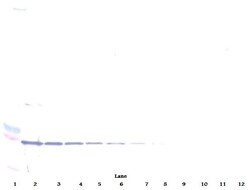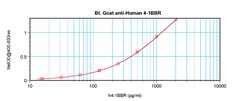Learn More
CD137 Polyclonal Antibody, Biotin, PeproTech®, Invitrogen™
Goat Polyclonal Antibody
$2175.00
Specifications
| Antigen | CD137 |
|---|---|
| Concentration | 0.1-1.0 mg/mL |
| Applications | ELISA, Western Blot |
| Classification | Polyclonal |
| Conjugate | Biotin |
| Catalog Number | Mfr. No. | Quantity | Price | Quantity & Availability | |||||
|---|---|---|---|---|---|---|---|---|---|
| Catalog Number | Mfr. No. | Quantity | Price | Quantity & Availability | |||||
50-271-8647

|
Invitrogen™
500P167GBT500UG |
500 μg |
Each of 1 for $2,175.00
|
|
|||||
Description
AA Sequence of recombinant protein: MERTRSLQDP CSNCPAGTFC DNNRNQICSP CPPNSFSSAG GQRTCDICRQ CKGVFRTRKE CSSTSNAECD CTPGFHCLGA GCSMCEQDCK QGQELTKKGC KNCCFGTFND QKRGICRPWT NCSLDGKSVL VNGTKERDVV CGPSPADLSP GASSVTPPAP AREPGHS. Preparation: Produced from sera of goats immunized with highly pure Recombinant Human 4-1BB Receptor. Anti-Human 4-1BB Receptor-specific antibody was purified by affinity chromatography and then biotinylated. Sandwich ELISA: To detect h4-1BB Receptor by sandwich ELISA (using 100 μL/well antibody solution) a concentration of 0.25-1.0 μg/mL of this antibody is required. This biotinylated polyclonal antibody, in conjunction with PeproTech Polyclonal Anti-Human 4-1BB Receptor (500-P167G) as a capture antibody, allows the detection of at least 0.2-0.4 ng/well of Recombinant h4-1BB Receptor. Western Blot: To detect h4-1BB Receptor by Western Blot analysis this antibody can be used at a concentration of 0.1-0.2 μg/mL. Used in conjunction with compatible secondary reagents the detection limit for Recombinant h4-1BB Receptor is 1.5-3.0 ng/lane, under either reducing or non-reducing conditions. 500-P167GBT-1MG will be provided as 2 x 500 μg
CD137, also known as TNFRSF9 or 4-1BB, is an inducible costimulatory molecule expressed mainly on activated T cells. Its ligand, known as 4-1BBL, is expressed on activated macrophages, mature B cells, hematopoietic stem cells, and myeloid progenitor cells. CD137 signaling leads to maintaining the survival of activated T cells and CD8+ memory T cells, and clonal expansion of T cells, but also to suppressing myelopoiesis and dendritic cell development. Triggered CD137 induces a cytokine release profile regulating peripheral monocyte survival. Soluble forms of CD137 may provide negative control mechanism for some immune responses.Specifications
| CD137 | |
| ELISA, Western Blot | |
| Biotin | |
| Goat | |
| Human | |
| Q07011 | |
| 3604 | |
| E.coli-derived Recombinant Human 4-1BB Receptor. | |
| Antigen affinity chromatography | |
| TNFRSF9 |
| 0.1-1.0 mg/mL | |
| Polyclonal | |
| Lyophilized | |
| RUO | |
| PBS with no preservative | |
| 4 1 BB; 41BB; 4-1BB; 4-1BB ligand receptor; A930040I11Rik; AA408498; AI325004; Cd137; CD137 antigen; CDw137; EGK_00183; homolog of mouse 4-1BB; ILA; induced by lymphocyte activation (ILA); interleukin-activated receptor, homolog of mouse Ly63; Ly63; receptor protein 4-1BB; s4 1 BB; s4 1BB; s41BB; sCD137; secreted CD137 antigen; soluble 4 1 BB; soluble 4 1BB; soluble 41BB; soluble CD137; T cell antigen ILA; T-cell antigen 4-1BB; T-cell antigen 4-1BB homolog; T-cell antigen ILA; TNF receptor superfamily member 9; TNFRSF9; Tumor necrosis factor receptor superfamily member 9; tumor necrosis factor receptor superfamily, member 9 | |
| TNFRSF9 | |
| Primary | |
| -20°C |
The Fisher Scientific Encompass Program offers items which are not part of our distribution portfolio. These products typically do not have pictures or detailed descriptions. However, we are committed to improving your shopping experience. Please use the form below to provide feedback related to the content on this product.


